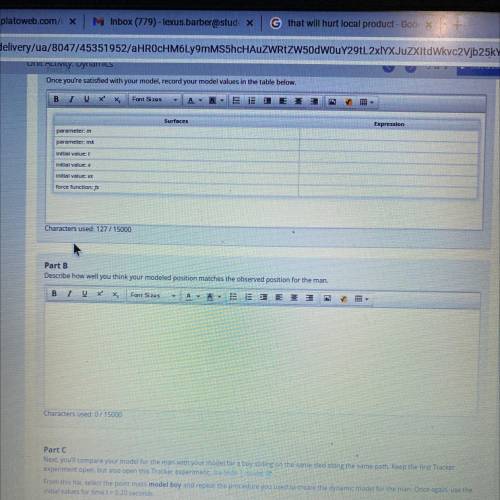
Physics, 27.10.2021 14:00 cameronbeaugh
Now that you know how forces affect the motions of objects, you can use the Tracker video analysis tool to create dynamic models
for a wide range of physical situations.
Tracker enables you to create two different types of mathematical models: analytical and dynamic. An analytical model enables you
to enter mathematical expressions for x and y positions as a function of time. That's sometimes useful, but from a physics
perspective, a dynamic model is much more flexible and powerful.
A dynamic model enables you to set the initial conditions for a particular system (Initial positions and velocities); then you can
mathematically define any forces acting on that system. Once those are set up, the model acts like an object in space, responding to
the forces you've imposed on it. It can continue moving forever, if that's what the forces would do to an object in real life. By visually
matching a marker for your model to the real motion on the video, you can define and refine a mathematical model for a wide range
of real-world situations.
In the first two tasks of this Unit Activity, you'll create dynamic models for motions in both one and two dimensions.
Activity Research - Creating a Dynamic Particle Model
Before you begin, do a little research and find out where you can get help in creating your models. In Tracker, you can always access
illustrated help to do anything. In Tracker, you can always access the illustrated Help dialog (? In the Toolbar).
For this project, you're going to need to check out the Tracker Help Instructions for Dynamic Models. You can print this Help
document, but it is available from Tracker anytime you need to refer to it.
For this project, you're going to need to check out the Tracker Help Instructions for creating a dynamic model.
Instructions - Building your Dynamic Model


Answers: 1
Another question on Physics

Physics, 22.06.2019 06:30
What are similarities and differences between refraction, reflection, diffraction and absorption?
Answers: 3

Physics, 22.06.2019 20:00
An element becomes a positively charged ion when itloses protons.loses electrons.gains electrons.gains neutrons.
Answers: 2

Physics, 23.06.2019 00:00
A15,000 kg rocket traveling at +230 m/s turns on its engines. over a 6.0 s period it burns 1,000 kg of fuel. an observer on the ground measures the velocity of the expelled gases to be −1,200 m/s.
Answers: 3

Physics, 23.06.2019 01:20
Question 1 of 15 2 points when doing science as inquiry, you should have some idea of what you think the final result will be. o a. true o b. false submit
Answers: 1
You know the right answer?
Now that you know how forces affect the motions of objects, you can use the Tracker video analysis t...
Questions

Computers and Technology, 10.03.2021 21:40


Social Studies, 10.03.2021 21:40


Social Studies, 10.03.2021 21:40

Chemistry, 10.03.2021 21:40




Mathematics, 10.03.2021 21:40

Business, 10.03.2021 21:40





Biology, 10.03.2021 21:40

Biology, 10.03.2021 21:40


Mathematics, 10.03.2021 21:40

Mathematics, 10.03.2021 21:40



